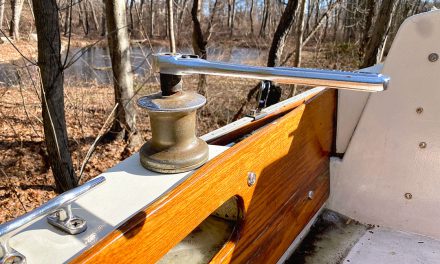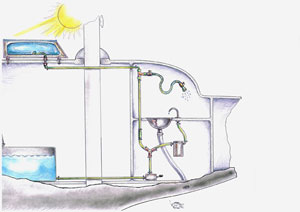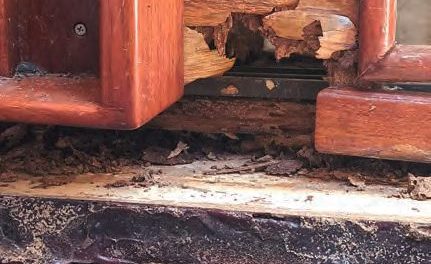Installing a foot pump in the galley is a great way to save water
Issue 153: Nov/Dec 2023
On many sailboats, the biggest use of fresh water is for washing dishes, which was the case on our 1993 Moody 44, Da Capo. The previous owner had downsized the water tanks, and while that might have worked great for a retired couple, it was difficult for our family of five if we didn’t have easy access to water or if it hadn’t rained for a while. Given our positive experience with a galley saltwater pump on a previous boat, it was a quick decision t o install one on Da Capo as well. We just had to figure out the best way to do it.
The type of foot pump that elegantly hides in a cabinet and only has a foot pedal sticking out was not an option for us because we needed the limited space available under the sink for storing our pots and pans. However, the bilge right behind the galley sink is relatively deep and was mostly empty. A round type of foot pump would fit perfectly there.

A Y-fitting was run off the water intake.
In order to have only the round foot pedal poking out of the floorboard, we needed to cut a hole the size of its diameter. Following the rule of “measure twice, cut once,” I measured at least three times before drilling a circle into the floorboard with a circular saw drill bit. The diameter would allow anyone standing behind the galley sinks to comfortably pump water with their right foot, while the body of the pump would be neatly hidden under the floorboard.
The next step was to install a Y-fitting on an existing throughhull. The 12 throughhulls on Da Capo are already too many for my liking, so finding a way to branch off an existing one was a must. The closest underwater opening to our galley sink is the starboard aft toilet water intake. While that might not sound ideal, the toilet valve assures that this is a one-way route — any toilet content cannot flow back the other way. With the seacock closed, I installed a Y-fitting, which allowed me to lead a short hose t o the next bilge compartment, where I planned to install the saltwater pump.
Given that feet would be pressing on the pump at least three times a day, we needed a solid support for it. An inset in the bilge compartment for a potential second floorboard provided a convenient ledge for a piece of plywood. Simply placing the plywood on top of the ledge would have been the easiest solution, but that wouldn’t leave enough space for the body of the pump to fit under the floorboard.
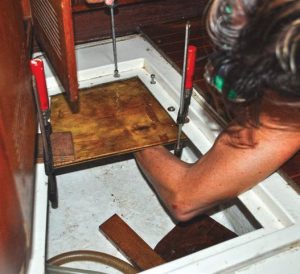
The author bolts in the epoxied plywood support.
To create maximum stability, I affixed my plywood piece with two Fclamps exactly where I wanted it to sit. Then I drilled six 3/32 holes through the ledge and the plywood piece. Before going any further, I took the rest of the afternoon to cover the plywood with two layers of epoxy. I had learned from another installation that plywood on boats — and particularly in galleys where moisture is inevitable — never lasts long. The epoxy should keep any water from getting into the plywood and make it last much longer.
The next morning, I installed the epoxied plywood with screws and washers on top and bottom. To give the board even more stability, I wedged a couple of support pieces of wood between the bottom of the bilge and the plywood support, so any pressure from the top would encounter resistance from the bottom.
I put the floorboard in place and traced the circle of the drilled hole onto the plywood support below. This was where the pump would sit. Then I took the floorboard off and fit the pump into place with one of my smallest drill bits, a screwdriver, and four small screws.
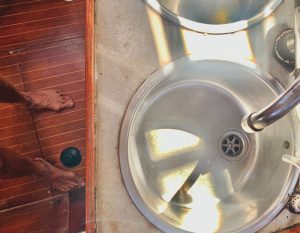
The finished project shows the pump on the floorboard and the extra tap for saltwater in the forward corner of the galley sink.
From there, I connected the hose that I had added to the Y-fitting to the water intake. A second hose leads from the pump, through the bilge, to the back of the aforementioned storage cabinet up to the tap that was conveniently part of the galley sink setup. Following best practice, every hose connection received a double hose clamp, each facing in a different direction. I made sure they were tight, but not so tight they would cut through the hose.
All that was left to do was set the floorboard back into place and test out the pump. Everything worked perfectly, despite the kids’ initial excited temptation to treat the pump as their new trampoline. As with most boat projects, planning was key — thinking every step through before even moving a finger, having all tools and implements ready and hoses measured out, and thinking twice so as to only have to drill once. Over and over again, I have found that putting in the extra effort during the visualization and preparation stages of any project saves so much time and energy down the track.
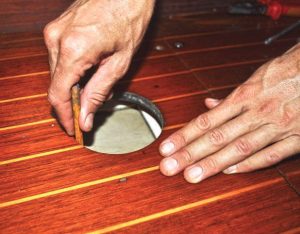
Dini draws a shape where the pump will be installed onto the plywood support below.
Our successful galley saltwater pump installation inspired us to add a foot pump for fresh water as well, and not just to save water. When our freshwater pump suddenly stopped working after a daylong passage, right before dinner, we realized how much we depend on a functioning electric system to access our fresh water, which is required to turn many of our dried food items into edible delicacies. If our batteries failed, we’d need to be quite creative to get water out of our tanks. That issue could easily be avoided with a manual pump, which also helps save water and electricity.
For now, finding space for another foot pump is the only thing holding us back. But we will also find a solution for that.
Dini Martinez has lived on boats on and off for most of her life, including work on superyachts, three years with a baby and a toddler around the Mediterranean, and years of coastal cruising around her homeland’s Down Under. Since 2021 she has been sailing the Caribbean with her family on a Moody 44, running yoga and tantra retreats. You can find out more about her on Instagram @Dini_Martinez and at DiniMartinez.com.
Thank you to Sailrite Enterprises, Inc., for providing free access to back issues of Good Old Boat through intellectual property rights. Sailrite.com


